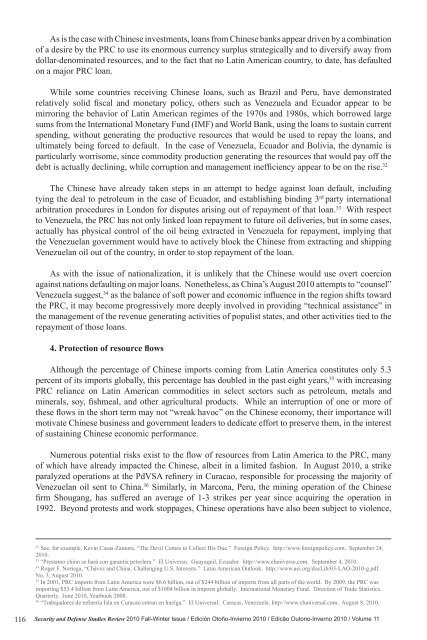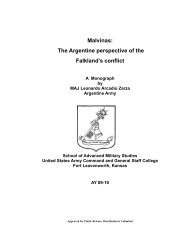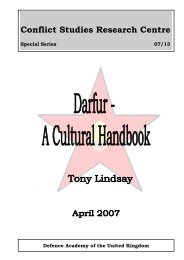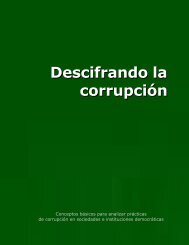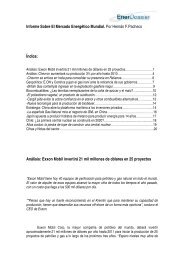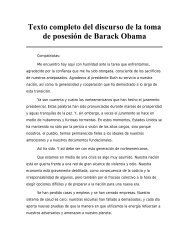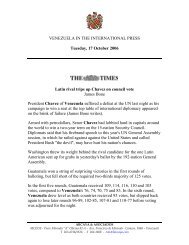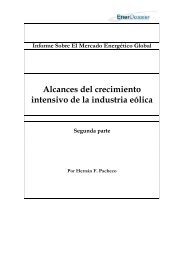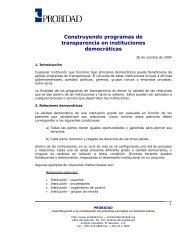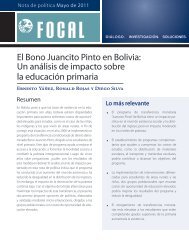As is the case with Chinese investments, loans from Chinese banks appear driven by a combinationof a desire by the PRC to use its enormous currency surplus strategically <strong>and</strong> to diversify away fromdollar-denominated resources, <strong>and</strong> to the fact that no Latin American country, to date, has defaultedon a major PRC loan.While some countries receiving Chinese loans, such as Brazil <strong>and</strong> Peru, have demonstratedrelatively solid fiscal <strong>and</strong> monetary policy, others such as Venezuela <strong>and</strong> Ecuador appear to bemirroring the behavior of Latin American regimes of the 1970s <strong>and</strong> 1980s, which borrowed largesums from the International Monetary Fund (IMF) <strong>and</strong> World Bank, using the loans to sustain currentspending, without generating the productive resources that would be used to repay the loans, <strong>and</strong>ultimately being forced to default. In the case of Venezuela, Ecuador <strong>and</strong> Bolivia, the dynamic isparticularly worrisome, since commodity production generating the resources that would pay off thedebt is actually declining, while corruption <strong>and</strong> management inefficiency appear to be on the rise. 32The Chinese have already taken steps in an attempt to hedge against loan default, includingtying the deal to petroleum in the case of Ecuador, <strong>and</strong> establishing binding 3 rd party internationalarbitration procedures in London for disputes arising out of repayment of that loan. 33 With respectto Venezuela, the PRC has not only linked loan repayment to future oil deliveries, but in some cases,actually has physical control of the oil being extracted in Venezuela for repayment, implying thatthe Venezuelan government would have to actively block the Chinese from extracting <strong>and</strong> shippingVenezuelan oil out of the country, in order to stop repayment of the loan.As with the issue of nationalization, it is unlikely that the Chinese would use overt coercionagainst nations defaulting on major loans. Nonetheless, as China’s August <strong>2010</strong> attempts to “counsel”Venezuela suggest, 34 as the balance of soft power <strong>and</strong> economic influence in the region shifts towardthe PRC, it may become progressively more deeply involved in providing “technical assistance” inthe management of the revenue generating activities of populist states, <strong>and</strong> other activities tied to therepayment of those loans.4. Protection of resource flowsAlthough the percentage of Chinese imports coming from Latin America constitutes only 5.3percent of its imports globally, this percentage has doubled in the past eight years, 35 with increasingPRC reliance on Latin American commodities in select sectors such as petroleum, metals <strong>and</strong>minerals, soy, fishmeal, <strong>and</strong> other agricultural products. While an interruption of one or more ofthese flows in the short term may not “wreak havoc” on the Chinese economy, their importance willmotivate Chinese business <strong>and</strong> government leaders to dedicate effort to preserve them, in the interestof sustaining Chinese economic performance.Numerous potential risks exist to the flow of resources from Latin America to the PRC, manyof which have already impacted the Chinese, albeit in a limited fashion. In August <strong>2010</strong>, a strikeparalyzed operations at the PdVSA refinery in Curacao, responsible for processing the majority ofVenezuelan oil sent to China. 36 Similarly, in Marcona, Peru, the mining operation of the Chinesefirm Shougang, has suffered an average of 1-3 strikes per year since acquiring the operation in1992. Beyond protests <strong>and</strong> work stoppages, Chinese operations have also been subject to violence,32See, for example, Kevin Casas-Zamora, “The Devil Comes to Collect His Due.” Foreign Policy. http://www.foreignpolicy.com. September 24,<strong>2010</strong>.33“Prestamo chino se hará con garantía petrolera.” El Universo. Guayaquil, Ecuador. http://www.eluniverso.com. September 4, <strong>2010</strong>.34Roger F. Noriega, “Chávez <strong>and</strong> China: Challenging U.S. Interests.” Latin American Outlook. http://www.aei.org/docLib/03-LAO-<strong>2010</strong>-g.pdf.No. 3, August <strong>2010</strong>.35In 2001, PRC imports from Latin America were $6.6 billion, out of $244 billion of imports from all parts of the world. By 2009, the PRC wasimporting $53.4 billion from Latin America, out of $1004 billion in imports globally. International Monetary Fund. Direction of Trade Statistics.Quarterly. June <strong>2010</strong>, Yearbook 2008.36“Trabajadores de refinería Isla en Curacao entran en huelga.” El Universal. Caracas, Venezuela. http://www.eluniversal.com. August 8, <strong>2010</strong>.116<strong>Security</strong> <strong>and</strong> <strong>Defense</strong> <strong>Studies</strong> <strong>Review</strong> <strong>2010</strong> <strong>Fall</strong>-Winter Issue / Edicíón Otoño-Invierno <strong>2010</strong> / Edicão Outono-Inverno <strong>2010</strong> / Volume 11
such as the takeover of CNPC oilfields in Tarapoa, Ecuador in November 2006,37 or the protestsagainst Petroriental in Orellana that turned violent in July 2007, ultimately forcing the Ecuadorangovernment to declare a state of emergency. 38The increasing presence of Chinese companies on the ground in Latin America, <strong>and</strong> in particularin mining <strong>and</strong> petroleum extraction in remote areas with complex populations, is likely to spawn arange of challenges with which those companies, with or without the support of the PRC government,will have to deal. On one h<strong>and</strong>, new operations, such as those proposed by the mining firm Tonglingin Corriente copper belt of southern Ecuador, 39 or those planned at Toromocho, Rio Blanco, <strong>and</strong>Galleno in Peru, are likely to spawn unrest with local populations over a range of issues, from Chinesemanagement practices <strong>and</strong> the use of Chinese versus local workers, to issues of invasion of <strong>and</strong> rightsto the l<strong>and</strong>, issues. (These generated violence by indigenous groups in the remote Peruvian region ofBagua in 2009.) Already, the new Chinese mining project in Toromocho has run into problems withresidents of the town of Morococha, which is located on the mining site <strong>and</strong> has to be relocated bythe concession owner, China Aluminum Corporation (Chinalco). 40Chinese operations in remote areas will increasingly involve the shipment of high value-addedgoods through relatively isolated mountainous, or jungle terrain, where security of the shipmentswill be a challenge. Chinese suppliers, customers, facility operators such as Hutchison-Whampoa,<strong>and</strong> logistics firms such as China Shipping <strong>and</strong> China Overseas Shipping Company (COSCO) willalso have to concern themselves with port <strong>and</strong> airport security, including not only the risk that theirmerch<strong>and</strong>ise will be stolen, but also that it could be used for the shipment of narcotics <strong>and</strong> otherillegal activities, which could ultimately lead to a police incident causing a costly disruption of theiroperations.In protecting its resource flows, the PRC will also have to prepare for the risk of radical politicalchange, <strong>and</strong> associated violence, which has frequently occurred in the region. A civil war, suchas that which seemed possible in Bolivia during the 2007-2008 timeframe; the expansion of anarcoinsurgency, such as that of Sendero Luminoso in the valley of the Apurimac <strong>and</strong> Ene rivers(VRAE) in Peru, or an interstate conflict, such as that between Colombia <strong>and</strong> Venezuela, could havea major disruptive influence on Chinese extractive operations. An even more serious problem wouldbe violent regime collapse, were the escalating crisis of governability to exp<strong>and</strong> out of control ina state such as Venezuela, with significant ongoing Chinese oil <strong>and</strong> mining operations <strong>and</strong> a wellarmedlocal militia with a strategy of decentralized resistance to fight against challengers to theregime.5. Protection of Chinese nationals <strong>and</strong> operations in the regionAs noted in the previous section, the expansion of Chinese commercial projects in Latin Americawill be accompanied by a growth in the number of Chinese companies, businessmen <strong>and</strong> othernationals on the ground in the region, in a context in which the nature of their activity, <strong>and</strong> theirlocation often in remote areas, will put them in harm’s way with respect to criminals, guerrillas, <strong>and</strong>simply un-accepting, potentially violent local populations. The growing occurrence of incidentssuch as those seen in Tarapoa in 2006 <strong>and</strong> Orellana in 2007 will force the PRC <strong>and</strong> its companies toconsider the question of how to best ensure the security of its personnel.37“Concluye toma de petrolera china Andes Petroleum.” El Universo. Guayaquil, Ecuador. http://www.eluniverso.com. November 11, 2006.38“Protestas contra Petroriental dejan 31 heridas en ocho días.” El Comercio. Quito, Ecuador. http:www.elcomercio.com. July 4, 2007.39“Tongling, China Railway Plan to Invest $3 Billion in Ecuador Copper Mine.” Bloomberg. http://www.bloomberg.com. August 13, <strong>2010</strong>.40See, for example, “Minera CHINALCO en Morococha tras los pasos de SHOUGANG. Mantuvo cerrada vía de acceso a Yauli por 1 año. Alcaldeimpone principio de autoridad. ¿A quién pertenece el Perú?” http://marconaprotesta.wordpress.com/2008/08/27/minera-chinalco-en-morocochatras-los-pasos-de-shougang-mantuvo-cerrada-via-de-acceso-a-yauli-por-1-ano-alcalde-impone-principio-de-autoridad-%C2%BFel-peru-a-quienpertenece/.<strong>Security</strong> <strong>and</strong> <strong>Defense</strong> <strong>Studies</strong> <strong>Review</strong> <strong>2010</strong> <strong>Fall</strong>-Winter Issue / Edicíón Otoño-Invierno <strong>2010</strong> / Edicão Outono-Inverno <strong>2010</strong> / Volume 11 117
- Page 2 and 3:
Security and Defense Studies Review
- Page 4 and 5:
CommentariesSecurity Cooperation Be
- Page 6:
6Security and Defense Studies Revie
- Page 9 and 10:
El espacio de las mujeres en las Fu
- Page 11 and 12:
La organización e institucionaliza
- Page 14 and 15:
encuentra altamente asociada al cam
- Page 16 and 17:
ministerial para la equidad de gén
- Page 19 and 20:
BibliografíaBarrancos, Dora (2007)
- Page 21 and 22:
Anexo IPaísIncorporación Femenina
- Page 23:
Anexo IIMujeres militares sudameric
- Page 26:
Todo un conjunto de cualidades, cap
- Page 29:
500 y durante la Batalla de Sarand
- Page 32 and 33:
miembros de la soberanía de la Nac
- Page 34 and 35:
10 de octubre de ese año, la Compa
- Page 36 and 37:
algunos barcos de apoyo para alberg
- Page 38 and 39:
1.75 metros de altura y como requis
- Page 40 and 41:
de producción sustituyendo al homb
- Page 42 and 43:
y sicológica, no sólo en los ámb
- Page 44 and 45:
La segunda etapa se caracterizó po
- Page 46 and 47:
Sin embargo, las preguntas acerca d
- Page 48 and 49:
La normativa vinculada con la asign
- Page 50 and 51:
conductas que pudieran encuadrarse
- Page 52 and 53:
Género en el marco de las Operacio
- Page 54 and 55:
ecordar que las ciencias sociales y
- Page 56 and 57:
56Security and Defense Studies Revi
- Page 58 and 59:
De ese modo nos encontramos con mod
- Page 60 and 61:
escala descendente de la oficialida
- Page 62 and 63:
del total. Debe destacarse que dent
- Page 64 and 65:
BibliografíaCarreiras, H.: Gender
- Page 66 and 67: Tras la aprobación de esta histór
- Page 68 and 69: Una vez aprobada la Resolución 132
- Page 70 and 71: para designar asesores de género e
- Page 73 and 74: firme se ha materializado en la ado
- Page 76 and 77: la construcción de la paz, la reco
- Page 78 and 79: Sin embargo, a medida que avanzaba
- Page 81 and 82: Women on the Front Lines of the Fig
- Page 83 and 84: term even has meaning any longer wi
- Page 85 and 86: following graduation. 15 Of course,
- Page 87 and 88: including members from other Americ
- Page 89 and 90: Solidariedade ou interesse? O que l
- Page 91 and 92: em mais amplo e complexo. 7A possib
- Page 93 and 94: Participação dos Estados-Membros
- Page 95: sujeitos a alguma OMP. Aqueles que,
- Page 98 and 99: às recomendações das Fases II, I
- Page 100 and 101: Franco, que assumira após o Impeac
- Page 102 and 103: O Brasil, por intermédio do Presid
- Page 104 and 105: No entanto, no tocante especificame
- Page 106 and 107: Portanto, não se consegue visualiz
- Page 108 and 109: ReferênciasAlmeida Pinto, J.R. de;
- Page 110 and 111: ______. United Nations Department o
- Page 112 and 113: Beyond economic activities, the PRC
- Page 114 and 115: soy oil into the country, a flow wh
- Page 118 and 119: In some cases, Chinese companies, l
- Page 120 and 121: Although it is not possible to pred
- Page 122 and 123: Considering this, we will now go fr
- Page 124 and 125: The contribution of Chilean troops
- Page 126 and 127: within and outside the nation?3. Ho
- Page 128 and 129: 128Security and Defense Studies Rev
- Page 130 and 131: 130Security and Defense Studies Rev
- Page 132 and 133: the Iran-Contra affair, one of the
- Page 134 and 135: all American hostages were released
- Page 136 and 137: “As he frequently said with pride
- Page 138 and 139: making operation 48 was conducted s
- Page 140 and 141: secret army alongside skilled profi
- Page 142 and 143: public than Kelly, taking issue wit
- Page 144 and 145: Some conservatives, even within the
- Page 146 and 147: opponents that he was “getting pr
- Page 148 and 149: for Defense (SUBDEF)—could initia
- Page 150 and 151: Hence, our countries are showing a
- Page 152 and 153: I am referring to Ibero-American Su
- Page 154 and 155: Thus, our country has agreed to the
- Page 156 and 157: sustraer mi producción intelectual
- Page 158 and 159: hombres (22,288).• Inclusión. Al
- Page 160 and 161: La perspectiva de trabajar en el di
- Page 162 and 163: 162Security and Defense Studies Rev
- Page 164 and 165: assignment on the U.S. Secretary of
- Page 166 and 167:
las Operaciones de Paz se abren a u
- Page 168 and 169:
ConclusiónA modo de conclusión, u
- Page 170 and 171:
170Security and Defense Studies Rev
- Page 172 and 173:
offering insight into political ter
- Page 174 and 175:
goods, and skilled labor must all b
- Page 176 and 177:
country” like North Korea. To be
- Page 178 and 179:
178Security and Defense Studies Rev
- Page 180 and 181:
views of women, in effect disabling
- Page 182 and 183:
Marine Col. William T. Hewes’ arg
- Page 184 and 185:
19. Hughes, Melanie M. (2007) “Un
- Page 186 and 187:
MacEoin. Commonweal 14: 8-11.This i
- Page 188 and 189:
37. Sans Echaìniz, María. (1992)
- Page 190 and 191:
47. Woodward, Rachel, and Patricia
- Page 192 and 193:
elucidativos das dificuldades que e
- Page 194 and 195:
194Security and Defense Studies Rev
- Page 196 and 197:
of an integrated Canadian company i
- Page 198 and 199:
198Security and Defense Studies Rev
- Page 200 and 201:
stated it would rightfully infringe
- Page 202 and 203:
First, through an examination of de
- Page 204 and 205:
204Security and Defense Studies Rev
- Page 206 and 207:
impact on the reader, by acknowledg
- Page 208 and 209:
To the Editor:Kevin P. Newmeyer’s
- Page 210 and 211:
Whitney Hoft was a Center for Hemis
- Page 212 and 213:
The transformation of the role of w
- Page 214 and 215:
en Puerto Rico, esta soldada resume
- Page 216 and 217:
Deconstruyendo a Ollie: Cómo los c
- Page 218:
Center for Hemispheric Defense Stud


